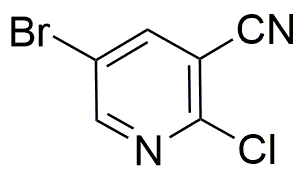5-Bromo-2-chloro-3-cyanopyridine is widely utilized in research focused on:
- Pharmaceutical Development: This compound serves as a key intermediate in the synthesis of various pharmaceuticals, particularly in the development of anti-cancer and anti-inflammatory agents.
- Agricultural Chemicals: It is used in the formulation of agrochemicals, contributing to the creation of effective pesticides and herbicides that help improve crop yields.
- Material Science: The compound is explored in the development of new materials, including polymers and coatings, due to its unique chemical properties that enhance durability and resistance.
- Research Reagents: As a versatile building block, it is commonly employed in laboratories for creating other complex molecules, aiding researchers in various chemical syntheses.
- Biochemical Applications: It plays a role in the study of biochemical pathways, helping researchers understand enzyme interactions and cellular processes, which is crucial for drug discovery.
General Information
Properties
Safety and Regulations
Applications
5-Bromo-2-chloro-3-cyanopyridine is widely utilized in research focused on:
- Pharmaceutical Development: This compound serves as a key intermediate in the synthesis of various pharmaceuticals, particularly in the development of anti-cancer and anti-inflammatory agents.
- Agricultural Chemicals: It is used in the formulation of agrochemicals, contributing to the creation of effective pesticides and herbicides that help improve crop yields.
- Material Science: The compound is explored in the development of new materials, including polymers and coatings, due to its unique chemical properties that enhance durability and resistance.
- Research Reagents: As a versatile building block, it is commonly employed in laboratories for creating other complex molecules, aiding researchers in various chemical syntheses.
- Biochemical Applications: It plays a role in the study of biochemical pathways, helping researchers understand enzyme interactions and cellular processes, which is crucial for drug discovery.
Documents
Safety Data Sheets (SDS)
The SDS provides comprehensive safety information on handling, storage, and disposal of the product.
Product Specification (PS)
The PS provides a comprehensive breakdown of the product’s properties, including chemical composition, physical state, purity, and storage requirements. It also details acceptable quality ranges and the product's intended applications.
Certificates of Analysis (COA)
Search for Certificates of Analysis (COA) by entering the products Lot Number. Lot and Batch Numbers can be found on a product’s label following the words ‘Lot’ or ‘Batch’.
*Catalog Number
*Lot Number
Certificates Of Origin (COO)
This COO confirms the country where the product was manufactured, and also details the materials and components used in it and whether it is derived from natural, synthetic, or other specific sources. This certificate may be required for customs, trade, and regulatory compliance.
*Catalog Number
*Lot Number
Safety Data Sheets (SDS)
The SDS provides comprehensive safety information on handling, storage, and disposal of the product.
DownloadProduct Specification (PS)
The PS provides a comprehensive breakdown of the product’s properties, including chemical composition, physical state, purity, and storage requirements. It also details acceptable quality ranges and the product's intended applications.
DownloadCertificates of Analysis (COA)
Search for Certificates of Analysis (COA) by entering the products Lot Number. Lot and Batch Numbers can be found on a product’s label following the words ‘Lot’ or ‘Batch’.
*Catalog Number
*Lot Number
Certificates Of Origin (COO)
This COO confirms the country where the product was manufactured, and also details the materials and components used in it and whether it is derived from natural, synthetic, or other specific sources. This certificate may be required for customs, trade, and regulatory compliance.


